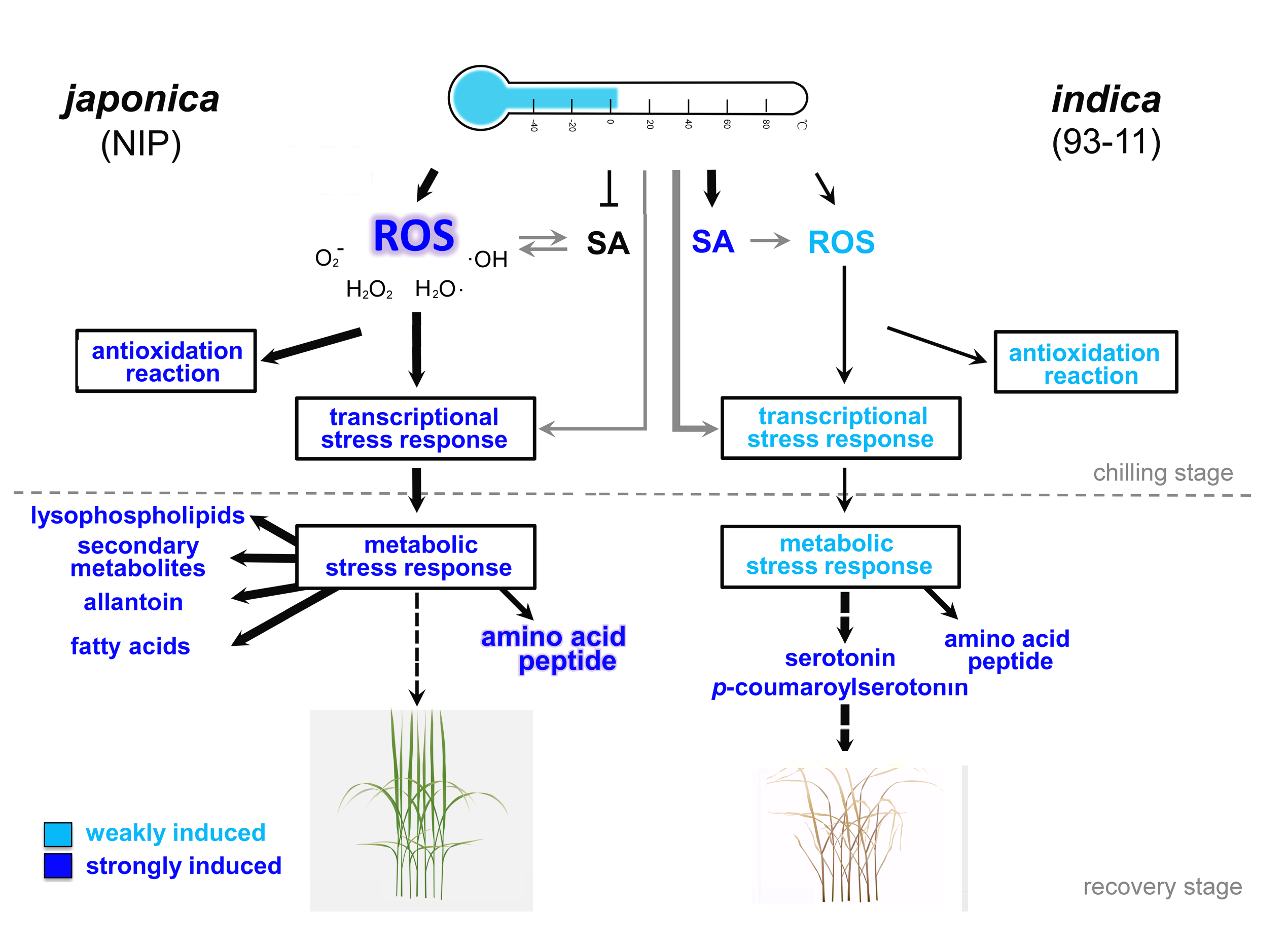Rice, the cereal crop providing food for more than half of the world’s population, evolved in tropical and subtropical areas and is sensitive to chilling stress. High chilling tolerance, therefore, is in urgent need to maintain rice production in current regions and expand it into areas with lower annual temperatures. Asian cultivated rice (Oryza sativa) consists of two major subspecies, indica and japonica, which show obvious divergence in chilling tolerance after artificial selection and domestication. Using these two types of rice materials, Prof. CHONG Kang’s Lab dissected mechanisms underlying the adaptation of rice plants to different environmental temperatures. Metabolomic and transcriptomic analysis revealed significant contribution of ROS-mediated gene regulation, rather than the well-known C-repeat binding factor/dehydration responsive-element binding factor (CBF/DREB) regulon, to the high chilling tolerance of japonica varieties. Different ROS-dominated chilling response networks, covering cold signal transduction as well as resulted transcriptional and metabolic fluctuation, were also uncovered for indica and japonica. Interestingly, under chilling treatment most significant biochemical changes were found to only center on antioxidation and some well-known anti-stress compounds were actually produced during recovery growth, which is different from traditional conception. Large-scale amino acid accumulation occurred, which is consistent with the appearance of chilling injury and could be used as its biomarker. This study uncovers dynamic metabolic models underlying chilling response and recovery, and reveals the ROS-dominated rice adaptation mechanism to low-temperature environments, which not only helps us to obtain a deeper understanding of the adaptation of plants to unfavorable environments, but also have considerable potential in cold-resistant genetic engineering (New Phytologist, 2016, doi: 10.1111/nph.14011).

Figure 1. Metabolomic analysis, SNP scanning and biochemical staining uncovered the critical role of ROS in the adaptation of rice plants to different environmental temperatures. Yellow and blue colors denote up- and down-regulation of metabolites, as well as 100% and 0% of survival rates, respectively.

Figure 2. Different ROS-mediated chilling response models for rice (Oryza sativa) ssp. japonica and indica.
CONTACT INFO:
ZHANG Jingyu
Key Laboratory of Plant Molecular Physiology
Institute of Botany,
Chinese Academy of Sciences,
20 Nanxincun, Xiangshan, Beijing 100093, China
E-mail: jingyuzhang@ibcas.ac.cn
Rice, the cereal crop providing food for more than half of the world’s population, evolved in tropical and subtropical areas and is sensitive to chilling stress. High chilling tolerance, therefore, is in urgent need to maintain rice production in current regions and expand it into areas with lower annual temperatures. Asian cultivated rice (Oryza sativa) consists of two major subspecies, indica and japonica, which show obvious divergence in chilling tolerance after artificial selection and domestication. Using these two types of rice materials, Prof. CHONG Kang’s Lab dissected mechanisms underlying the adaptation of rice plants to different environmental temperatures. Metabolomic and transcriptomic analysis revealed significant contribution of ROS-mediated gene regulation, rather than the well-known C-repeat binding factor/dehydration responsive-element binding factor (CBF/DREB) regulon, to the high chilling tolerance of japonica varieties. Different ROS-dominated chilling response networks, covering cold signal transduction as well as resulted transcriptional and metabolic fluctuation, were also uncovered for indica and japonica. Interestingly, under chilling treatment most significant biochemical changes were found to only center on antioxidation and some well-known anti-stress compounds were actually produced during recovery growth, which is different from traditional conception. Large-scale amino acid accumulation occurred, which is consistent with the appearance of chilling injury and could be used as its biomarker. This study uncovers dynamic metabolic models underlying chilling response and recovery, and reveals the ROS-dominated rice adaptation mechanism to low-temperature environments, which not only helps us to obtain a deeper understanding of the adaptation of plants to unfavorable environments, but also have considerable potential in cold-resistant genetic engineering (New Phytologist, 2016, doi: 10.1111/nph.14011).

Figure 1. Metabolomic analysis, SNP scanning and biochemical staining uncovered the critical role of ROS in the adaptation of rice plants to different environmental temperatures. Yellow and blue colors denote up- and down-regulation of metabolites, as well as 100% and 0% of survival rates, respectively.

Figure 2. Different ROS-mediated chilling response models for rice (Oryza sativa) ssp. japonica and indica.
CONTACT INFO:
ZHANG Jingyu
Key Laboratory of Plant Molecular Physiology
Institute of Botany,
Chinese Academy of Sciences,
20 Nanxincun, Xiangshan, Beijing 100093, China
E-mail: jingyuzhang@ibcas.ac.cn